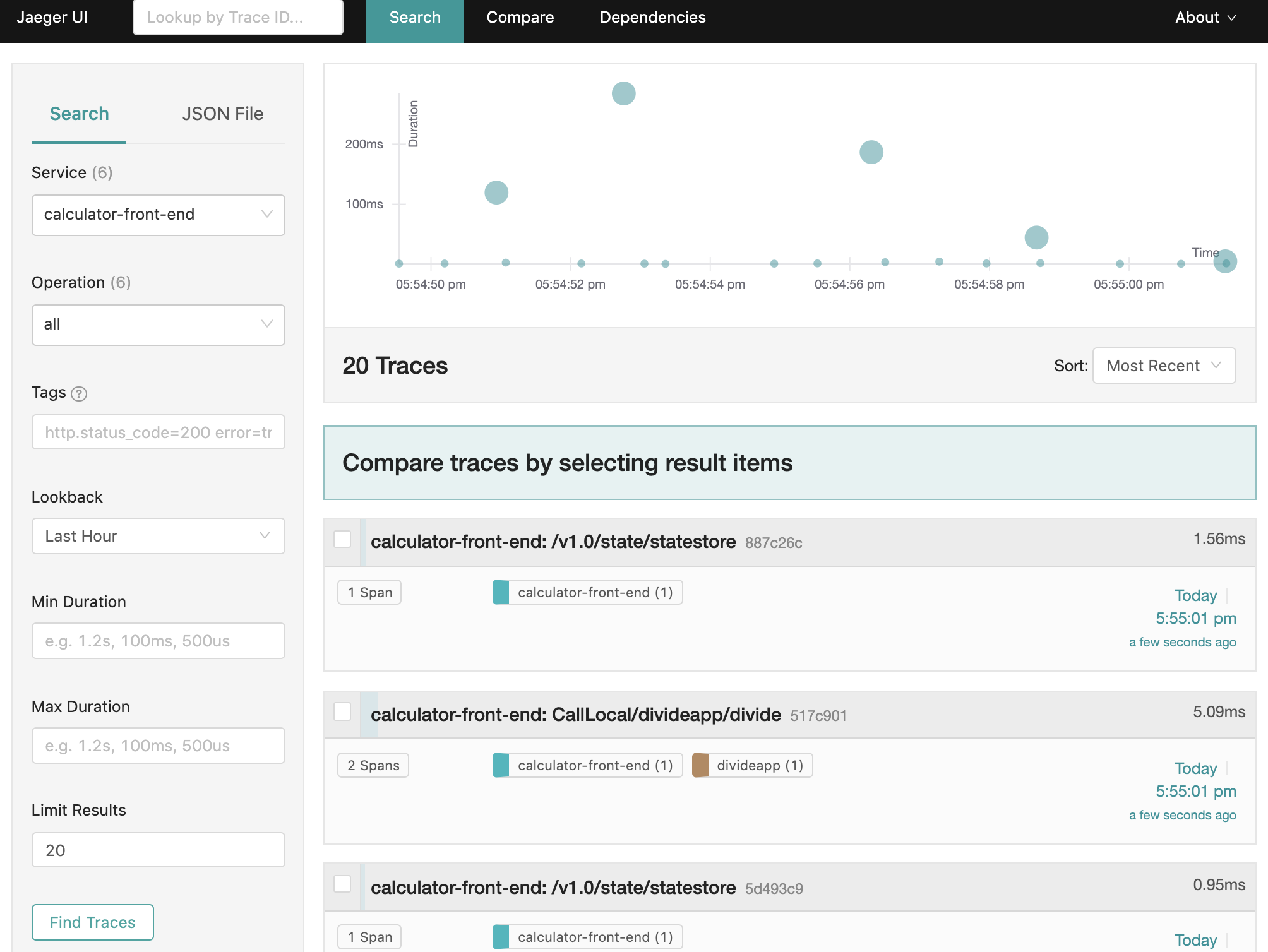使用 OpenTelemetry Collector 收集追踪信息并发送到 Jaeger
Dapr 支持通过 OpenTelemetry (OTLP) 和 Zipkin 协议进行追踪信息的写入。然而,由于 Jaeger 对 Zipkin 的支持已被弃用,建议使用 OTLP。虽然 Jaeger 可以直接支持 OTLP,但在生产环境中,推荐使用 OpenTelemetry Collector 从 Dapr 收集追踪信息并发送到 Jaeger。这样可以让您的应用程序更高效地处理数据,并利用重试、批处理和加密等功能。更多信息请阅读 Open Telemetry Collector 文档。
在自托管模式下配置 Jaeger
本地设置
启动 Jaeger 的最简单方法是运行发布到 DockerHub 的预构建的 all-in-one Jaeger 镜像,并暴露 OTLP 端口:
docker run -d --name jaeger \
-p 4317:4317 \
-p 16686:16686 \
jaegertracing/all-in-one:1.49
接下来,在本地创建以下 config.yaml 文件:
注意: 因为您使用 Open Telemetry 协议与 Jaeger 通信,您需要填写追踪配置的
otel部分,并将endpointAddress设置为 Jaeger 容器的地址。
apiVersion: dapr.io/v1alpha1
kind: Configuration
metadata:
name: tracing
namespace: default
spec:
tracing:
samplingRate: "1"
stdout: true
otel:
endpointAddress: "localhost:4317"
isSecure: false
protocol: grpc
要启动引用新 YAML 配置文件的应用程序,请使用 --config 选项。例如:
dapr run --app-id myapp --app-port 3000 node app.js --config config.yaml
查看追踪信息
要在浏览器中查看追踪信息,请访问 http://localhost:16686 查看 Jaeger UI。
在 Kubernetes 上使用 OpenTelemetry Collector 配置 Jaeger
以下步骤展示了如何配置 Dapr 以将分布式追踪数据发送到 OpenTelemetry Collector,然后将追踪信息发送到 Jaeger。
前提条件
- 在 Kubernetes 上安装 Dapr
- 使用 Jaeger Kubernetes Operator 设置 Jaeger
设置 OpenTelemetry Collector 推送到 Jaeger
要将追踪信息推送到您的 Jaeger 实例,请在您的 Kubernetes 集群上安装 OpenTelemetry Collector。
-
下载并检查
open-telemetry-collector-jaeger.yaml文件。 -
在
otel-collector-confConfigMap 的数据部分,更新otlp/jaeger.endpoint值以匹配您的 Jaeger collector Kubernetes 服务对象的端点。 -
将 OpenTelemetry Collector 部署到运行 Dapr 应用程序的相同命名空间中:
kubectl apply -f open-telemetry-collector-jaeger.yaml
设置 Dapr 发送追踪信息到 OpenTelemetryCollector
创建一个 Dapr 配置文件以启用追踪,并将 sidecar 追踪信息导出到 OpenTelemetry Collector。
-
使用
collector-config-otel.yaml文件创建您自己的 Dapr 配置。 -
更新
namespace和otel.endpointAddress值以与部署 Dapr 应用程序和 OpenTelemetry Collector 的命名空间对齐。 -
应用配置:
kubectl apply -f collector-config.yaml
部署启用追踪的应用程序
通过在您希望启用分布式追踪的应用程序部署中添加 dapr.io/config 注释来应用 tracing Dapr 配置,如下例所示:
apiVersion: apps/v1
kind: Deployment
metadata:
...
spec:
...
template:
metadata:
...
annotations:
dapr.io/enabled: "true"
dapr.io/app-id: "MyApp"
dapr.io/app-port: "8080"
dapr.io/config: "tracing"
您可以同时注册多个追踪导出器,追踪日志将被转发到所有注册的导出器。
就是这样!无需包含 OpenTelemetry SDK 或对您的应用程序代码进行检测。Dapr 会自动为您处理分布式追踪。
查看追踪信息
要查看 Dapr sidecar 追踪信息,请端口转发 Jaeger 服务并打开 UI:
kubectl port-forward svc/jaeger-query 16686 -n observability
在您的浏览器中,访问 http://localhost:16686,您将看到 Jaeger UI。

参考资料
Feedback
Was this page helpful?
Glad to hear it! Please tell us how we can improve.
Sorry to hear that. Please tell us how we can improve.